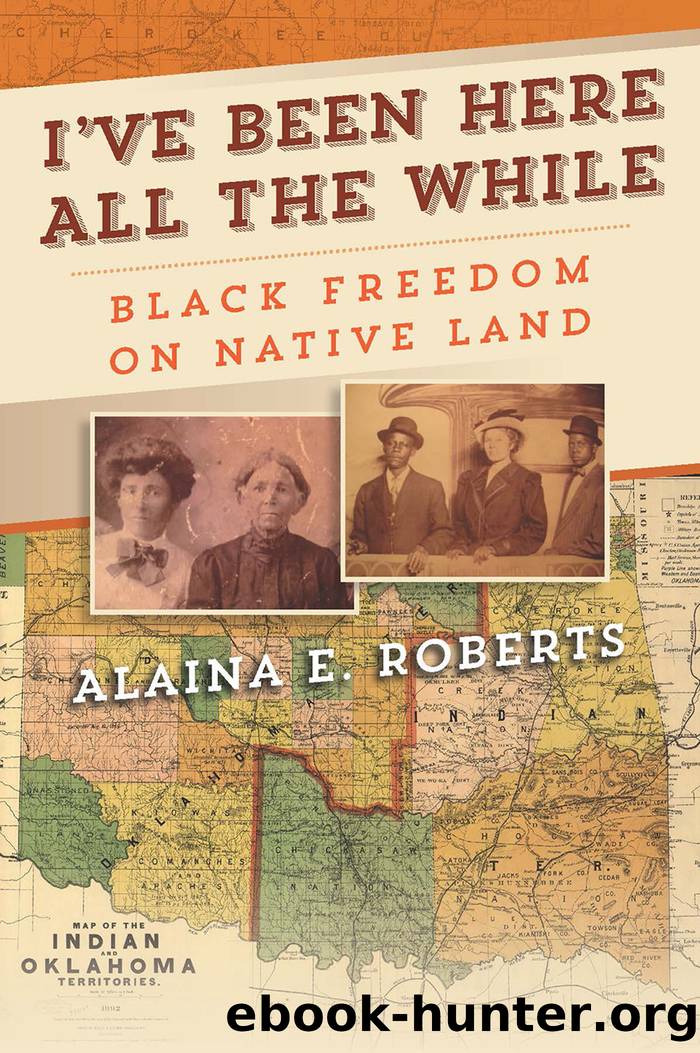I've Been Here All the While: Black Freedom on Native Land by Alaina E. Roberts

Author:Alaina E. Roberts [Roberts, Alaina E.]
Language: eng
Format: epub
Tags: history, United States, 19th Century, Americas (North; Central; South; West Indies), African American & Black
ISBN: 9780812253030
Google: Jk4gEAAAQBAJ
Publisher: University of Pennsylvania Press
Published: 2021-04-05T00:11:30.102523+00:00
FIGURE 7. Great Seal of the state of Oklahoma.
Though unwilling to see them as the permanent, rightful owners of the land or even as equal partners in diplomacy, white settlers were eager to use Native peoples as representations of this new state. This sort of representation is a part of the settler colonial processâas the actual prior residents diminish in number and in influence, they become important symbols of the settler colonial stateâs past. The Oklahoma state seal is a veritable smorgasbord of symbolism starting with the very method by which it came to be: the idea for the seal was taken from that proposed by representatives of the Five Tribes at the Sequoyah Convention. Literally and metaphorically, this new state was created from that which was taken from the Native peoples of Indian Territory.
On the seal, the Five Tribes make up a five-pointed star (representing one of the stars that symbolize each individual American state on the American flag), with each point of the star encapsulating each Indian nationâs seal. In the middle of the star, inside a wreath, a Native man wearing the headdress of a Plains Indian shakes the hand of a white man in front of a figure of blind Justice, symbolizing equality for the two races. Perhaps most telling of all, above Justiceâs head are the Latin words âLabor Omnia Vincit,â which translate to âlabor conquers all things.â Reflecting white settlersâ belief that hard work, rather than support of the settler colonial process, led to their success, the adage is an interesting juxtaposition to the stateâs modern-day colloquial name, âthe Sooner State,â which honors those who refused to abide by legal and moral rules requiring them to wait to stake their claim to land during the 1889 Land Run.
With statehood came many profound changes for people of Native and African descent. But one thing that stayed the sameâor actually worsenedâwas white economic exploitation. By 1895 speculators had located the major petroleum and natural-gas fields within several of the Five Tribes but largely failed to realize their vast potential; this would take several more years. White settlers would exploit these resources through the use of a new tool: guardianship.66 Land allotment carried with it distinctions between different âclassesâ of people. Indian freedpeople received less land than those deemed Indians, but even among Indians there was an important difference imposed after allotment was processed: oneâs supposed racial identity determined the actions they could take with regard to their land. After many arguments, hearings, testimonies, and letters between politicians, tribal citizens, reformers, and speculators, white American legislators decided that those Indians deemed âfull-bloodedâ were barred from the ability to âalienate, sell, dispose of, or encumber in any mannerâ the entirety of their allotment for 25 years after the passage of the 1906 Five Tribes Act (until 1931). During this period, their allotments were also not taxed.67 This was a way to paternalistically protect them from swindlers and force them to learn the ways of yeoman agriculture.68 Mixed-race persons
Download
This site does not store any files on its server. We only index and link to content provided by other sites. Please contact the content providers to delete copyright contents if any and email us, we'll remove relevant links or contents immediately.
| Africa | Americas |
| Arctic & Antarctica | Asia |
| Australia & Oceania | Europe |
| Middle East | Russia |
| United States | World |
| Ancient Civilizations | Military |
| Historical Study & Educational Resources |
Machine Learning at Scale with H2O by Gregory Keys | David Whiting(4190)
Never by Ken Follett(3796)
Fairy Tale by Stephen King(3220)
The Man Who Died Twice by Richard Osman(2997)
Oathbringer (The Stormlight Archive, Book 3) by Brandon Sanderson(2890)
Will by Will Smith(2794)
Rationality by Steven Pinker(2291)
The Dark Hours by Michael Connelly(2246)
Can't Hurt Me: Master Your Mind and Defy the Odds - Clean Edition by David Goggins(2229)
The Dawn of Everything: A New History of Humanity by David Graeber & David Wengrow(2123)
Friends, Lovers, and the Big Terrible Thing by Matthew Perry(2123)
Principles for Dealing With the Changing World Order: Why Nations Succeed and Fail by Ray Dalio(1974)
HBR's 10 Must Reads 2022 by Harvard Business Review(1778)
A Short History of War by Jeremy Black(1763)
Go Tell the Bees That I Am Gone by Diana Gabaldon(1687)
515945210 by Unknown(1601)
A Game of Thrones (The Illustrated Edition) by George R. R. Martin(1591)
Kingdom of Ash by Maas Sarah J(1529)
443319537 by Unknown(1470)
